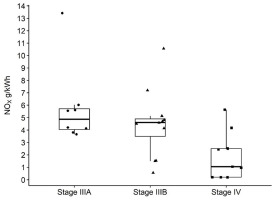当前位置:
X-MOL 学术
›
Atmos. Environ.
›
论文详情
Our official English website, www.x-mol.net, welcomes your
feedback! (Note: you will need to create a separate account there.)
Real-world emissions from non-road mobile machinery in London
Atmospheric Environment ( IF 4.2 ) Pub Date : 2020-02-01 , DOI: 10.1016/j.atmosenv.2020.117301 C.D. Desouza , D.J. Marsh , S.D. Beevers , N. Molden , D.C. Green
Atmospheric Environment ( IF 4.2 ) Pub Date : 2020-02-01 , DOI: 10.1016/j.atmosenv.2020.117301 C.D. Desouza , D.J. Marsh , S.D. Beevers , N. Molden , D.C. Green

|
Abstract The 2016 London atmospheric emissions inventory estimates that, the construction sector contributes 34% of the total PM10 and 7% of the total NOX – the largest and 5th largest sources, respectively. Recent on-road light duty diesel vehicle emission tests have shown significant differences between real-world NOX emissions compared with results from laboratory based regulatory tests. The aim of this study was therefore to quantify the ‘real-world’ tail-pipe NOX, CO2, and particle emissions, for 30 of the most commonly used construction machines in London under normal working conditions. The highest NOX emissions (g/kWh) were from the older engines (Stage III-A ~4.88 g/kWh and III-B ~4.61 g/kWh), these were reduced significantly (~78%) in the newer (Stage IV ~1.05 g/kWh) engines due to more advanced engine management systems and exhaust after treatment. One Stage IV machine emitted NOX similar to a Stage III-B machine, the failure of this SCR was only detectable using PEMS as no warning was given by the machine. Higher NOX conformity factors were observed for Stage IV machines, due to the lower NOX emission standards, which these machines must adhere to. On average, Stage III-B machines (~525 g/kWh) emitted the lowest levels of CO2 emissions, compared to Stage III-A (~875 g/kWh) and Stage IV (~575 g/kWh) machines. Overall, a statistically significant (~41%) decrease was observed in the CO2 emissions (g/kWh) between Stage III-A and III-B machines, while no statistically significant difference was found between Stage III-B and IV machines. Particle mass measurements, which were only measured from generators, showed that generators of all engine sizes were within their respective Stage III-A emission standards. A 95% reduction in NOX and 2 orders of magnitude reduction in particle number was observed for a SCR-DPF retrofitted generator, compared to the same generator prior to exhaust gas after-treatment strategy.
中文翻译:

伦敦非道路移动机械的真实排放
摘要 2016 年伦敦大气排放清单估计,建筑业占 PM10 总量的 34% 和 NOX 总量的 7%,分别是最大和第五大来源。最近的道路轻型柴油车排放测试表明,与基于实验室的监管测试结果相比,真实世界的 NOX 排放存在显着差异。因此,本研究的目的是量化伦敦 30 台最常用的建筑机械在正常工作条件下的“真实世界”尾气 NOX、CO2 和颗粒排放。最高的 NOX 排放(g/kWh)来自旧发动机(Stage III-A ~4.88 g/kWh 和 III-B ~4.61 g/kWh),这些在较新(Stage IV)中显着降低(~78%) 〜1。05 g/kWh) 发动机由于更先进的发动机管理系统和排气后处理。一台 Stage IV 机器排放的 NOX 类似于 Stage III-B 机器,该 SCR 的故障只能使用 PEMS 检测到,因为机器没有发出警告。由于这些机器必须遵守较低的 NOX 排放标准,因此在 Stage IV 机器上观察到更高的 NOX 合规系数。平均而言,与 Stage III-A (~875 g/kWh) 和 Stage IV (~575 g/kWh) 机器相比,Stage III-B 机器 (~525 g/kWh) 排放的二氧化碳排放量最低。总体而言,在 Stage III-A 和 III-B 机器之间观察到的 CO2 排放量 (g/kWh) 在统计上显着 (~41%) 下降,而在 Stage III-B 和 IV 机器之间没有发现统计学上的显着差异。粒子质量测量,仅从发电机测量的结果表明,所有发动机尺寸的发电机均符合其各自的 III-A 排放标准。与采用废气后处理策略之前的相同发电机相比,SCR-DPF 改装发电机的 NOX 减少了 95%,颗粒数量减少了 2 个数量级。
更新日期:2020-02-01
中文翻译:

伦敦非道路移动机械的真实排放
摘要 2016 年伦敦大气排放清单估计,建筑业占 PM10 总量的 34% 和 NOX 总量的 7%,分别是最大和第五大来源。最近的道路轻型柴油车排放测试表明,与基于实验室的监管测试结果相比,真实世界的 NOX 排放存在显着差异。因此,本研究的目的是量化伦敦 30 台最常用的建筑机械在正常工作条件下的“真实世界”尾气 NOX、CO2 和颗粒排放。最高的 NOX 排放(g/kWh)来自旧发动机(Stage III-A ~4.88 g/kWh 和 III-B ~4.61 g/kWh),这些在较新(Stage IV)中显着降低(~78%) 〜1。05 g/kWh) 发动机由于更先进的发动机管理系统和排气后处理。一台 Stage IV 机器排放的 NOX 类似于 Stage III-B 机器,该 SCR 的故障只能使用 PEMS 检测到,因为机器没有发出警告。由于这些机器必须遵守较低的 NOX 排放标准,因此在 Stage IV 机器上观察到更高的 NOX 合规系数。平均而言,与 Stage III-A (~875 g/kWh) 和 Stage IV (~575 g/kWh) 机器相比,Stage III-B 机器 (~525 g/kWh) 排放的二氧化碳排放量最低。总体而言,在 Stage III-A 和 III-B 机器之间观察到的 CO2 排放量 (g/kWh) 在统计上显着 (~41%) 下降,而在 Stage III-B 和 IV 机器之间没有发现统计学上的显着差异。粒子质量测量,仅从发电机测量的结果表明,所有发动机尺寸的发电机均符合其各自的 III-A 排放标准。与采用废气后处理策略之前的相同发电机相比,SCR-DPF 改装发电机的 NOX 减少了 95%,颗粒数量减少了 2 个数量级。











































 京公网安备 11010802027423号
京公网安备 11010802027423号